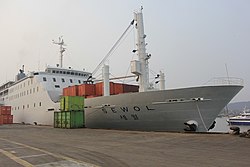User:Allard
Hello and a warm welcome to all my fellow Wikipedians. How nice of you to drop in to see who I am!
Morning>
Wikipedia & me:
[edit]How I discovered Wikipedia, I do not remember. But from being a reader I slowly became a contributor. Although I don't work that much on Wikipedia I do see myself as a Wikipedian. I don't go searching on Wikipedia what I can edit next, I edit what I find and want to do. This means I add and mainly improve a lot of small things and only rarely I make large edits.
My work:
[edit]Articles I've started on Wikipedia:
- Fort Knox Bullion Depository
- Animals are Beautiful People
- Template:David Attenborough Television Series
- Template:Malta Islands
Images I made for Wikipedia:
 Dutch lower house as from 2006
Dutch lower house as from 2006 New image of the Netherlands Air Force Roundel
New image of the Netherlands Air Force RoundelMap on membership of the League of Nations
United Nations membership map
 Improved image of the British Helgoland flag
Improved image of the British Helgoland flag New image showing the current flag of Hel(i)goland
New image showing the current flag of Hel(i)goland
Article guide:
[edit]A list of articles worth looking at, if one can find them:
- Antidisestablishmentarianism
- Ball's Pyramid
- British Isles (terminology)
- Eadweard Muybridge
- Gunpowder Plot
- Horace de Vere Cole
- Humphrey (cat)
- Islomania
- List of countries by date of nationhood
- List of flags
- List of people who died on their birthdays
- List of regnal numerals of future British monarchs
- List of unusual deaths
- Northwest Angle
- Quadripoint
- Racetrack Playa
- Rule of tincture
- San Gimignano
- Transcontinental country
- Undivided India & Partition of India
- Voyager Golden Record
- Web colors
- Winchester Mystery House
And there's always the Random article
And to all citizens of the European Union, please read this: Oneseat.eu
News
[edit]- A nightclub roof collapse in Santo Domingo, Dominican Republic, kills 231 people.
- In basketball, the UConn Huskies win the NCAA Division I women's championship (Most Outstanding Player Azzi Fudd pictured) and the Florida Gators win the men's championship.
- In the National Hockey League, Alexander Ovechkin breaks Wayne Gretzky's record for most goals scored.
- In horse racing, Nick Rockett, ridden by Patrick Mullins, wins the Grand National.
Selected anniversaries
[edit]- 1520 – A revolt of citizens in Toledo, Castile, opposed to the rule of the foreign-born Charles I began when the royal government attempted to unseat radical city councilors.
- 1862 – Slavery in Washington, D.C., ended when the District of Columbia Compensated Emancipation Act became law.
- 1945 – Second World War: British and Canadian forces concluded the Liberation of Arnhem in the Netherlands from German occupation.
- 1948 – The Organisation for European Economic Co-operation, headquartered in Paris, was founded.
- 2014 – The ferry MV Sewol (pictured) capsized and sank off Donggeochado, South Korea, killing 306 people, mainly students from Danwon High School.
- Frederick I, Duke of Austria (d. 1198)
- Molly Brant (d. 1796)
- Ponnambalam Ramanathan (b. 1851)
Did you know...
[edit]- ... that the Seth Peterson Cottage (pictured) was said to have "more architecture per square foot" than any of Frank Lloyd Wright's other designs?
- ... that Robert Van Damme played ice hockey professionally before pursuing a career in gay pornography?
- ... that a 2023 tornado damaged Selma, Alabama, known for civil-rights marches attended by Martin Luther King Jr., just eight days before MLK Day?
- ... that Pitty recorded Admirável Chip Novo with a band hastily assembled from Salvador musicians after rejecting Rio de Janeiro's session musicians because it felt "strange"?
- ... that Joseph Pearman played American football with F. Scott Fitzgerald at a preparatory school?
- ... that A Polish Book of Monsters features stories in which the line between monster and human is blurred, reflecting what the editor saw as a quintessentially Polish view of monstrosity?
- ... that an Indian restaurant chain has more than 800 combinations of kulfi flavours, toppings, and sauces?
- ... that some mill workers in a historic district in Virginia gave their ages as fourteen despite appearing much younger?
- ... that Yi chieftain Xiao Yedan and a Chinese Red Army military leader established an alliance by drinking chicken blood?
Today's featured article
[edit]The mind is that which thinks, feels, perceives, imagines, remembers, and wills, including both conscious and unconscious processes. Its exact nature is debated, like whether mental phenomena are internal activities of transforming information or dispositions to engage in observable behavior. The mind–body problem is the challenge of explaining the relation between matter and mind. According to physicalism, minds are not independent entities but certain aspects of material objects. The evolutionary history of the mind is tied to the development of brains, but it is controversial at which point minds emerged and which non-human animals possess minds. Similar theoretical challenges concern the possibility of artificial minds powered by computers. The main fields studying the mind include psychology, neuroscience, cognitive science, and the philosophy of mind. Their methods range from empirical observation and neuroimaging to conceptual analysis and thought experiments. (Full article...)











